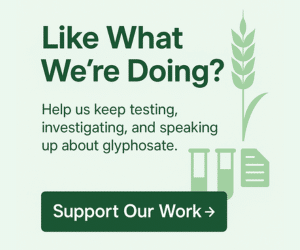One might assume new chemicals are rigorously tested before approval. But what’s actually being tested — and what’s not — might surprise you.
When a new chemical gets approved for use in New Zealand — whether it’s a herbicide, pesticide, fungicide, or some other “cide” — most people assume that it’s been through rigorous safety testing. Not just the bare chemical skeleton, but the whole product that will eventually be sprayed on our food, land, and water.
But what if that assumption is wrong?
The truth is: most of the time, only the active ingredient is tested — and even that’s usually based on industry-supplied data, not independent science. The full formulation — the version you and I are exposed to — isn’t always tested for long-term health effects, endocrine disruption, environmental impact, or chronic exposure risks. In fact, in many cases, it isn’t tested at all.
That’s not just a scientific oversight. It’s a legal one.
New Zealand law is clear: product labels must reflect the hazards of the product as sold — not just the active ingredient. If the full spray mix poses additional risks due to surfactants, solvents, or so-called “inert” ingredients, those hazards should be disclosed. But how can regulators test for hazards they don’t even know about? The answer is — they can’t. So they don’t.
Instead, the system puts its faith in the chemical companies’ data. And given what’s come to light in recent court cases — from Roundup to paraquat — that blind trust may be one of the greatest regulatory failures of our time.
As BusinessNZ pushes to fast-track chemical approvals based on decisions in “comparable markets,” it’s worth asking a very different question:
Are we even testing the right thing?
How New Zealand’s Chemical Approvals Rely on Industry Assumptions
On paper, New Zealand’s chemical approval system is supposed to protect people and the environment from harm. But in practice, it often starts from the assumption that industry data is reliable, that real-world use mirrors lab conditions, and that hazard can be determined by looking at a single ingredient in isolation.
These assumptions aren’t just outdated — they’re dangerous.
The Environmental Protection Authority (EPA) typically approves new hazardous substances based on information provided by the applicant — usually the manufacturer or distributor of the chemical. These data packages almost always focus on the declared active ingredient and its short-term toxic effects in controlled settings. In other words, how much of the pure ingredient it takes to cause immediate harm to a lab rat under ideal conditions.
But what’s missing from that picture?
- The other 95% of the formulation — surfactants, solvents, dispersants, preservatives, pH stabilisers — often kept secret under commercial confidentiality.
- Real-world exposure scenarios — where chemicals are sprayed across diverse ecosystems, used repeatedly, mixed with other substances, or drifted into homes and waterways.
- Long-term health outcomes — endocrine disruption, immune suppression, reproductive harm, neurotoxicity — none of which show up in short-term tests for acute poisoning.
The entire system is built on a fiction: that the active ingredient tells the whole story.
Yet independent studies, including a recent 2025 peer-reviewed analysis in Environmental Sciences Europe, reveal that pesticide formulations — as sold and used in the environment — have never been subjected by industry to long-term testing on mammals. Only a few independent studies have attempted this, and what they’ve found is troubling: the full products are often more toxic than the active ingredient alone.
So when BusinessNZ says we should fast-track approvals based on what other countries have approved, maybe we should be asking a different question:
What exactly did those countries approve — and what assumptions were baked into their decision-making?
The Loophole: Only the Active Ingredient Gets Tested
It’s one of the best-kept open secrets in chemical regulation: only the active ingredient is tested. Not the product as sold. Not the mixture sprayed over crops, school fields, forests, and home gardens.
Just the one chemical the manufacturer has chosen to highlight on the label.
This loophole exists not because it’s scientifically sound — but because it’s convenient. For regulators, it simplifies the approval process. For industry, it conceals the synergistic toxicity that can emerge when so-called “inert” ingredients are mixed in.
The exact recipe — the full chemical formulation — is often treated as commercially sensitive, like the KFC secret herbs and spices. But we’re not talking about seasoning here — we’re talking about solvents, surfactants, and preservatives that may make the final product more hazardous than the active ingredient alone.
And yet, as the law currently stands, hazard classifications and warning labels are supposed to reflect the product as sold and used — not just its main ingredient in isolation.
If the full product contains solvents that increase skin absorption, or surfactants that damage gut linings, those effects should be factored into risk assessments and label warnings. But in most cases, they’re not.
Why?
Because the exact recipe — the full formulation — is usually protected as a “trade secret.” Regulators may not even know what’s in it. And without knowing what’s in it, how can they test it?
So they don’t.
Instead, they rely on the company’s word. The assumption is that if the active ingredient looks safe in a controlled setting, the rest must be too. Never mind that studies have shown some so-called “inerts” are more toxic than the active ingredient itself.
And let’s be honest — if it’s not tested, it can’t be classified. If it’s not classified, it doesn’t need to be labelled. And if it’s not labelled, the public doesn’t ask questions.
It’s a regulatory disappearing act.
Thousands of Chemicals, Barely Scrutinised
If this was just about one or two products slipping through the cracks, it might be possible to write it off as administrative oversight.
But it’s not. It’s systemic.
New Zealand currently has around 150,000 hazardous substances approved for use. Out of those, only about 3,500 have individual approvals under the Hazardous Substances and New Organisms (HSNO) Act — and only a few hundred have been fully reassessed with up-to-date science or modern safety standards.
Let that sink in: we’re swimming in chemicals that have never had a proper second look — and often weren’t properly scrutinised the first time either.
This isn’t just speculation. In 2022, the Parliamentary Commissioner for the Environment (PCE) reported that our chemical management system is so underfunded and fragmented, it can’t even keep up with basic reassessments. The Environmental Protection Authority (EPA) later confirmed this in its 2023 ministerial briefing, stating it faced a $65 million shortfall over four years — and has minimal capacity for post-approval monitoring and enforcement.
So when industry groups like BusinessNZ say the system is too slow and needs to be “streamlined,” we need to ask: slow for whom — and at what cost?
Because the real problem isn’t that approvals take too long. The real problem is that once a chemical is approved — often based on outdated, minimal, or company-supplied data — there’s no meaningful follow-up. No tracking of how it’s used, where it ends up, or what happens when it accumulates across landscapes and generations.
This is what happens when a regulatory system is chronically underfunded and overburdened.
But imagine the alternative: a dedicated, well-resourced team tasked with independently testing, reassessing, and publicly reviewing every chemical currently in use in New Zealand — not just the ones flagged by industry for commercial reasons. A system that doesn’t just wave new products through, but actively works to reassess the backlog, retire outdated or unsafe chemicals, and close the formulation testing gap once and for all (more on how this could be funded below).
That wouldn’t just improve speed — it would improve trust.
And it would go a long way toward protecting our biodiversity, food system, and public health from chemical risks we still don’t fully understand.
Fast-Tracking Chemicals — But Skipping Safety?
BusinessNZ is calling for faster approvals of hazardous substances in New Zealand — arguing that if a product has already been approved in a “comparable market,” we should just rubber-stamp it here.
But that raises an uncomfortable question:
What counts as comparable — and what’s being compared?
Are we comparing regulatory systems that have similar biodiversity? Climate? Exposure patterns? Public health outcomes? Or are we just cherry-picking the most permissive countries with the weakest safeguards — and calling it efficiency?
Because if speed is the goal, consistency cuts both ways.
Many of the same countries we’re told to align with have already banned chemicals still used here. Take paraquat, for example — it has been banned or restricted in dozens of countries (including the EU). Yet in New Zealand, it remains approved under strict conditions rather than being fully prohibited, despite its well-documented risks to human health and the environment.
So here’s the real test:
If we’re going to fast-track approvals based on what others are doing — will we also fast-track bans when those same countries say a product is too dangerous?
Or is speed only desirable when it benefits the chemical industry?
This selective logic isn’t about improving safety. It’s about convenience. It’s about clearing the path for new commercial products — while turning a blind eye to the ones already causing harm.
And in the background, independent researchers and public watchdogs are left scrambling to fill the gaps — without the budget, mandate, or access that chemical companies enjoy by default.
If our regulatory system is too slow to protect us, the answer isn’t to lower the bar.
It’s to raise the resources, raise the standards, and raise the questions industry would rather we didn’t ask.
Who Does the EPA Really Work For?
Chemical companies don’t just provide the data used to approve their own products — in many cases, they also define the scope of the assessment itself.
Applicants decide which studies to submit, what risks to highlight, and how to frame the benefits. They rarely fund independent long-term studies — because they’re not required to. The result? A cost-benefit analysis tilted in favour of the applicant from the very beginning.
This is regulatory capture — not by force, but by structure.
As Matt Hall of the Environmental Law Initiative noted in his recent Post opinion piece, industry groups are now pushing to weaken an already underpowered approval system. Instead of funding stronger science, better monitoring, or more transparent oversight, they want to fast-track products based on someone else’s assessment — often from a country with a very different environment and regulatory culture.
And who carries the burden if something goes wrong?
Not the manufacturer. Not the applicant. Not the overseas regulator.
It’s New Zealanders — our ecosystems, our farmers, our food supply, and our public health system — that will absorb the risk.
If industry wants faster access to new products, shouldn’t they also contribute to the cost of independent evaluations, ongoing safety reviews, and the public right to know what’s in the chemical formulations being used across our landscapes?
The Environmental Protection Authority does charge fees to applicants — but in reality, these cover only a small fraction of the cost. According to its own figures, industry contributes as little as 16% toward the actual expenses of chemical assessments. The rest is paid by the public. So while the law allows for “actual and reasonable cost recovery,” the burden still falls mostly on taxpayers — funding approvals that primarily benefit private companies, while the long-term risks to health and the environment remain externalised.
Imagine if 100% of those costs were recovered. That alone could fund an independent, well-resourced team dedicated to evaluating, reassessing, and properly regulating the chemicals used across New Zealand. Instead of working around the gaps in the system, we could start closing them.
So we’re left with a simple but uncomfortable question:
Who is the current system really protecting?
Why New Zealand Needs Local Testing of Chemical Formulations
When industry groups argue that New Zealand should speed up chemical approvals by aligning with “comparable markets,” they often overlook a crucial fact: our environment is not like theirs.
We’re not Europe. We’re not North America. We’re New Zealand — a country home to nearly 28,000 unique species, over 4,000 of which are already threatened or at risk. What’s considered “safe” elsewhere might not be safe here, especially when local biodiversity is more vulnerable, and exposure pathways are different.
A herbicide sprayed on Canadian soy might degrade before it reaches groundwater. But sprayed on a hill in Gisborne, that same chemical could wash into streams, accumulate in estuaries, or drift across neighbouring land. The geography, climate, and usage patterns are different — and so are the stakes.
That’s why local testing — on local soils, under local conditions, using the actual formulations sold in New Zealand — matters more than ever.
And yet, when it comes to chemical regulation, New Zealand often acts like a policy taker — borrowing decisions from overseas regulators without questioning their relevance or rigour. We’re told it’s efficient. But efficiency isn’t the same as safety. And outsourcing science is no substitute for sovereignty.
We’re approving products for use here, on our land, in our waterways, and around our children. Shouldn’t we at least test them here too?
Chemical Safety in New Zealand: What Needs to Change
New Zealand’s chemical approval system isn’t just under pressure — it’s fundamentally out of step with what science, law, and public health demand.
We’re assessing active ingredients in isolation.
We’re approving products without long-term data.
We’re relying on industry-supplied studies and overseas decisions.
And we’re under-resourcing the very agency tasked with protecting us.
Meanwhile, the products being approved are full formulations — complex chemical cocktails sprayed over farms, forests, sports fields, schoolyards, and home gardens. The gap between what’s tested and what’s used isn’t just a technicality. It’s a legal, scientific, and ethical failure.
Fast-tracking that failure won’t fix it. It will only make it harder to undo.
If industry wants faster access to new chemicals, let them fund independent safety testing and long-term monitoring — here, under local conditions. Let’s build a system that reflects our biodiversity, respects our people, and restores public trust.
And let’s stop pretending that imported science, incomplete data, and cost-cutting serve the public interest.
Because when it comes to hazardous substances in New Zealand — the question shouldn’t be “how fast?”
It should be: “how thorough, how transparent, and how safe?”
Resources & References
We’ve referenced several key studies and expert sources throughout this article — not just to back up our claims, but to invite deeper reading. The more you explore, the clearer the pattern becomes: a regulatory system built on partial data, industry-led assumptions, and a startling lack of transparency. These resources help fill in what regulators often leave out — or leave unquestioned.
Scientists’ warning: we must change paradigm for a revolution in toxicology and world‑food supply
Seralini, G.-E. et al. (2025)
Environmental Sciences Europe.
A landmark peer‑reviewed study emphasising that pesticide formulations “as sold and used in the environment” have never been submitted by industry to long‑term mammalian testing, and that only the declared active ingredients have been assessed.
A review of published studies from 2010 to 2025 on glyphosate‑based herbicide formulations and co‑formulants.
Klátyik, S., Simon, G., Oláh, M. et al. (2025)
Archives of Toxicology.
Reviews the human‑health and ecosystem science on glyphosate (GLY) and its commercial formulations, highlighting how “inert” co‑formulants contribute significantly to toxicity.
Potential toxic effects of glyphosate and its commercial formulations.
Mesnage, R., Benbrook, C., Antoniou, M. et al. (2015)
Food and Chemical Toxicology.
A seminal review showing many formulations have never been tested for long‑term effects and that formulations often show higher toxicity than the active ingredient alone.
The EPA’s role and performance in assessing hazardous substances. [PDF]
Jeff Loan, Kelvin Woock (2023)
Sapere Research Group
Government briefing illustrating that New Zealand’s EPA faces a significant shortfall in funding and resourcing for chemical assessment, monitoring and enforcement.
Fees, charges and cost‑recovery principles
EPA NZ (2023) HSNO Act
Details the legal framework under section 21 of the HSNO Act that allows cost recovery from applicants, and shows that fees recover only a small portion of actual regulatory costs.
Additional Recommended Reading — Book Reviews on NoMoreGlyphosate.nz
(These are not peer‑reviewed studies but provide broader context and investigative insight.)
Toxic Legacy by Stephanie Seneff
A provocative exploration of how glyphosate may be silently undermining human health, and how regulation has largely ignored the risk.
The Monsanto Papers by Carey Gillam
Investigative journalism showing the internal playbook of a major agrochemical company and the legal battles behind glyphosate herbicides.
Whitewash by Carey Gillam
A powerful exposé of how science, media and regulation were influenced and shaped around herbicides and other chemicals for decades.
Unstoppable by Zen Honeycutt
One parent’s journey into citizen science, grassroots testing and activism to uncover what’s really in our food and environment.
Science should serve the public — not the marketing timelines of chemical companies. If we want better decisions, we need better data, better accountability, and a willingness to confront the uncomfortable. These studies, reports, and books don’t have all the answers — but they ask the right questions. And that’s where real change begins.
Image Source & Attribution
We’re grateful to the talented photographers and designers whose work enhances our content. The feature image on this page is by yanlev.




